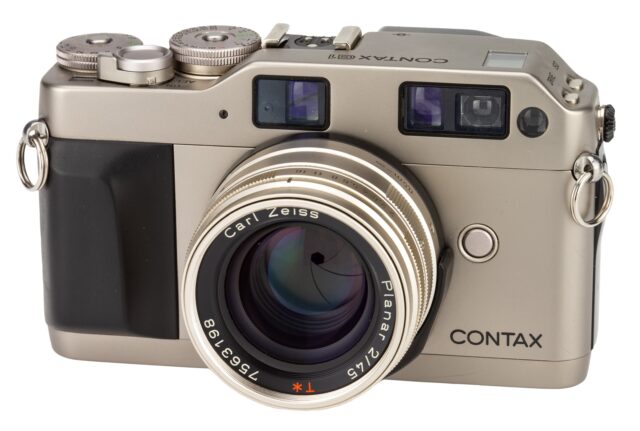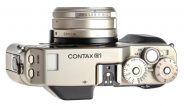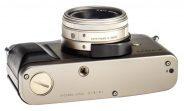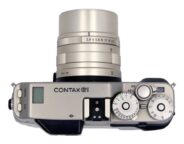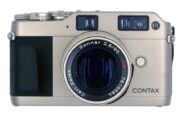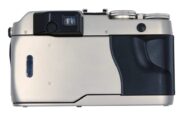Announced
Production status
System
Contax G1
35mm AF film rangefinder camera • Discontinued
Specification
| Format: | |
| 35mm full frame | |
Film type: | 135 cartridge-loaded film |
| Contax G [28.95mm] | |
| Shutter: | |
Type: | Focal-plane |
Model: | Electronically controlled |
Speeds: | 16 - 1/2000 + B |
| Exposure: | |
Exposure metering: | Through-the-lens (TTL), open-aperture |
Exposure modes: | Aperture-priority Auto |
| Manual | |
| Rangefinder and Viewfinder: | |
Rangefinder: | Built-in, combined with viewfinder |
Viewfinder: | Built-in, combined with rangefinder |
Finder magnification: | 0.57x |
Bright-line frames: | - |
Parallax compensation: | Yes |
| Physical characteristics: | |
Weight: | 460g |
Dimensions: | 133x77x42mm |
Manufacturer description #1
"I was caught by an irresistable impulse to possess this camera." It is unusual for a camera to honestly impress a photographer at first sight. The CONTAX G1 is an interchangeable lens, rangefinder AF system that continues the design concept established by the CONTAX RTSIII and reminds the user of the elegance and simplicity of the CONTAX T2. A rangefinder allows lens designers freedom to design more high performance optics without the compromises found in the SLR lens designs. Carl Zeiss has developed four new lenses of the highest quality perfectly matched for the CONTAX G1. The CONTAX G1 is ready and waiting for that "decisive moment". Once in your hands, you will be captivated by the elegant charm of the CONTAX G1, it is surely, the essence of perfection.
Two, Easy-To-Use Exposure Modes - Aperture Priority Or Manual Exposure.
Metering is accomplished via a TTL light metering system that employs a Silicon Photo Diode (SPD) in the upper central area of the camera body. Precise metering is achieved over a wide range of exposure values from EV1 to EV19. When using the Carl Zeiss Hologon T* 16mm lens the camera automatically switches to external metering.
The CONTAX G1 provides the two most popular metering methods preferred by advanced amateurs and professional photographers - aperture priority automation and manual exposure modes. The exposure is checked by a half-way depression of the shutter release button. AE Lock may be set by switching the main power lever to the AE Lock position. Manual exposures are set in the traditional manner by rotating the f-stop ring on the lens or changing the shutter speed on the camera body.
A Newly Developed Passive AF System With Extended Base Length For The Ultimate In Focusing Accuracy.
The CONTAX G1 employs a passive auto focus system which has an elongated base length (the distance between the two focusing windows) for the ultimate in focusing accuracy. The base length is the overriding factor that determines the accuracy of a rangefinder. The CONTAX G1 provides smooth, stepless focusing with extremely high accuracy. Focus information is transmitted to the high performance CPU which controls the built-in ultra-accurate motor in the camera body. An AF supplementary light is supplied in the camera body to assist focusing under low light and low contrast situations.
Manual Focusing Is Easy.
The focusing dial located in the top right corner of the camera allows super fast and easy manual focusing. Simply turn the focusing dial while pushing the focusing dial release button to enter the manual focus mode. A check of the focus indicator in the viewfinder or distance scale on the manual focus dial will immediately inform the user of focus distance. The outer scale of the focusing dial is used for both the 28mm and the 45mm lens while the inner scale is used for the 90mm. The distance is set directly on the focusing ring when using the Hologon T* 16mm lens.
A variable finder coupled to the taking lenses-bright, Real Image Viewfinder.
The finder of the CONTAX G1 is a highly accurate, bright real image viewfinder with a magnification of 0.57 and 90% field of view (at infinity with the 45mm lens mounted). Parallax correction is steplessly adjusted for each interchangeable lens fitted on the CONTAX G1. A wide range of diopter adjustments from +0.3 D to-2D can be set with the built-in diopter adjuster.
Large LCD Viewfinder Indicators.
Information such as shutter speed, exposure warning, flash ready signal, exposure compensation and an AF scale are clearly displayed in the viewfinder.
An Ultra Precision, High Durability Dual Motor System for Film Advance/Rewind & Shutter Operation.
The shutter is an electronically controlled focal plane shutter with speeds from 16 seconds to 1/2000 second in automatic mode and 1 second to 1/2000 second in manual exposure mode. The X Synch shutter speed is 1/100 second or slower and Bulb exposures are easily accommodated. Two high performance DC motors work independently to charge the shutter and advance/ rewind the film. The CONTAX G1 is of extremely high durability and provides smooth, almost noiseless operation because of the elimination of the mirror shock occuring in SLR type cameras.
A Wide Range Of Flash Functions Are Enabled.
The new CONTAX TLA-140 electronic flash was developed especially to accompany the CONTAX G1. This flash is small enough to fit into a shirt pocket but offers TTL flash capability on the CONTAX G1. Slow shutter synchronization and daylight fill-in flash may be accomplished easily by use of the AE Lock function. The CONTAX G1 can also utilize the TLA-280, TLA-360 and TLA-480 flashes routinely even with second curtain synchronization.
A TOOL OF PERFECT BEAUTY, TITANIUM BODY COVER. Titanium is used as a tough body covering on the CONTAX G1 camera body. Titanium is chosen for its light weight, high strength, shock and corrosion resistance as well as its beautiful finish. The surface of the camera body has been superbly finished, smooth and lustrous. The CONTAX G1 is a beautiful tool that will be a highly reliable partner for many years to come.
The CONTAX G1 allows selection of the following functions:
- Turn the main power switch to the AE Lock position for AE Lock. (Standard Setting)
- AE Lock is activated by pressing shutter release button halfway or turning main power switch to AEL position. (Custom Function)
- The order of the A.B.C. Standard/Over/Under Exposure (Standard Setting)
- Change the order of the A.B.C. to Over/Standard/ Under Exposure (Custom Function)
- Rewind the leader completely into the film cassette. (Standard Setting)
- Leave the film leader outside the film cassette after rewinding. (Custom Function)
SLR Functionality
Drive Modes & A.B.C. Function.
The CONTAX G1 provides all the drive modes you would expect to find on any CONTAX SLR such as single or continuous advance, self-timer and multiple exposures. Also, the Automatic Bracketing Control (A.B.C.), three frame continuous automatic exposure compensation system provides exposure bracketing in ±0.5EV and ±1.0EV increments. The A.B.C. system may be used without removing the eye from the viewfinder.
Ultra Strong Aluminum Die-Cast Chassis For Rock Hard Usage.
The lens mount is a newly developed CONTAX G mount of Spigot bayonet type attached securely to a precisely processed copper/silumin die-cast alloy chassis. This chassis is high temperature/high pressure steam annealed to eliminate distortion and provide high strength throughout.
Manufacturer description #2
We didn't just create a camera, we created a whole new class
Select the sophisticated elements from an SLR and add them to the essence of a compact camera... the result is the Contax G1. The G1 is more than a camera, it's a camera system that provides all the elements of control and precision expected from a Contax camera in a small, extremely versatile package.
The G1 system has four newly designed, interchangeable Carl Zeiss T* lenses including: the AF Biogon 28mm f2.8, AF Planar 45mm f2.0, AF Sonnar 90mm f2.8 and Hologon 16mm f8.0. These lenses make up the finest series of Carl Zeiss lenses ever. Additionally, your current T* SLR lenses can be used on the G1 with the GA-1 Mount Adapter.
The new, compact G1 lenses are designed to provide the highest contrast and resolution along with the lowest distortion obtainable. Since the G1 does not require a mirror box or pentaprism, lens designers had more freedom to design for higher optical performance. Further, since there is no mirror, vibration and noise are reduced to unbelievably low levels.
The viewfinder of the G1 zooms to match the installed lens and corrects automatically for parallax and focal distance. Also, coupled to the viewfinder is a +3D to -2D diopter, selectable by the user for easy use without eyeglasses.
The G1 has an advanced passive autofocus system with an extended base length, which is critical to enhanced accuracy compared with conventional compact cameras. Along with AF focusing, the G1 also has a manual focus system to preserve the ability of the photographer to choose.
Automatic Bracketing Control (A.B.C.) is built-in on the G1 and provides an automatic three frame continuous (over/right on/under) exposure system. Further control is possible via the exposure compensation system allowing exposure changes of +2EV to -2EV in 1/3 step increments. A Custom Function system is also built-in on the G1 to allow the photographer to customize various elements of camera performance.
The shutter is a focal plane vertical travel composite material providing lightweight and precision quartz timed shutter speeds. The shutter speed range on the G1 is from 1/2000 second to 16 seconds in automatic AE mode (1/2000 sec. to 1 sec. in manual mode).
Through The Lens (TTL) flash metering is standard on the G1, allowing perfectly exposed flash photographs every time with the new Contax TLA140 flash or other Contax TLA flashes.
Accessories abound in the new Contax G1 system, including filters, lens shades, power packs, accessory strap, deluxe leather system carrying cases, and a special Mount Adapter called the GA-1. It allows the Carl Zeiss T* SLR lenses to be used with the G1.
The Contax G1 is a state-of-the-art camera system that evokes the traditional qualities of Contax while pushing the limits of creative design into the 21st century.
Manufacturer description #3
Type: 35 mm AF range finder camera with focal plane shutter.
Shutter: Electronically-controlled vertical-travel focal-plane shutter.
Sync Contacts: Direct X contact (synchronizing speeds 1/100 sec. or slower), provided with sync terminal.
Metering System: TTL actual exposure metering (center-weighted average light metering) / External metering (automatic switchover with the mounted lens).
Focusing: Automatic focusing with focusing dial, switchable to manual focusing.
Viewfinder: Real-image viewfinder (coupling with the mounted lens), 0.57X magnification and 90% field of view (with 45mm lens, infinity and -1D diopter).
Display in viewfinder: Picture area frame (automatic parallax adjustment), focusing frame, focus display, shutter speed, exposure mark, exposure compensation, flash mark.
Accessory shoe: Direct X-contact hot shoe (provided with TLA flash contact).
Power Source: Two 3V lithium batteries (CR2).
